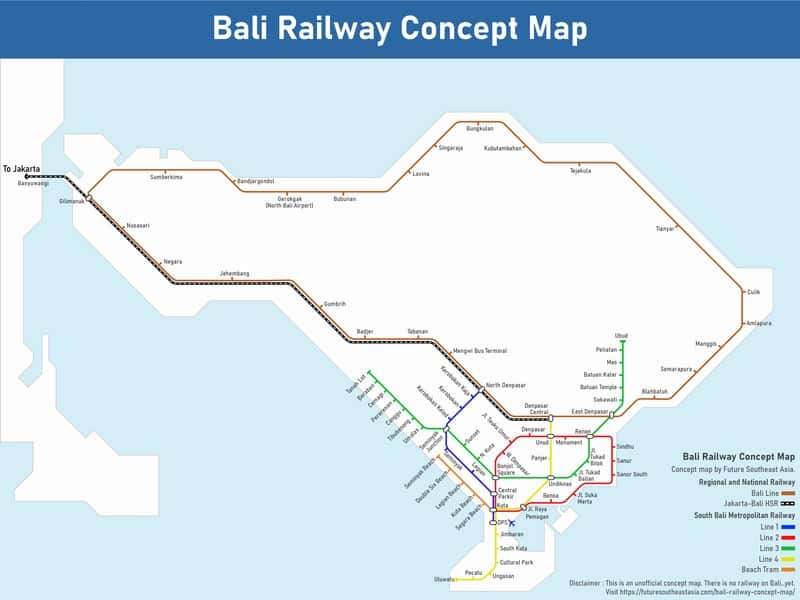
Bali, with its stunning landscapes, vibrant culture, and unparalleled tourism appeal, has long captured the hearts of travelers worldwide. Yet, as the island grapples with burgeoning tourist arrivals and escalating traffic congestion, the need for sustainable and efficient transportation solutions has never been more pressing. Enter the Bali Railway Network – an ambitious undertaking poised to transform the island’s transit landscape and redefine the way locals and tourists navigate its diverse terrain.
Chapter 1: A Decade of Ambition
The genesis of Bali’s railway aspirations can be traced back over a decade, with initial proposals surfacing as early as 2011. These early blueprints laid the foundation for what would evolve into a comprehensive vision for a modernized transit system. Over the years, successive administrations and stakeholders have contributed to shaping and refining these plans, each iteration bringing the island closer to realizing its railway dreams.
Chapter 2: The Bali Line – Circumnavigating Paradise
Central to the Bali Railway Network is the Bali Line, a circular railway envisioned to encircle the entire island. What began as a modest proposal for a three-quarters circumference route has since evolved into a more ambitious endeavor, with recent plans advocating for a complete circular alignment. This strategic initiative promises enhanced connectivity and accessibility, potentially servicing key locations such as the envisaged second Bali airport.
Chapter 3: Bridging Islands: The Jakarta-Bali High-Speed Connection
In a bid to integrate Bali into broader national infrastructure initiatives, plans for a Jakarta-Bali High-Speed Railway have gained traction. Envisaged to link Denpasar to Gilimanuk, this high-speed connection presents a transformative opportunity for seamless travel between Bali and Java. However, challenges abound, including the need to synchronize with existing railway networks and address logistical hurdles.
Chapter 4: Urban Mobility Redefined
Beyond long-distance connections, the Bali Railway Network aims to revolutionize urban transit in South Bali. Proposals for metro, light rail, and tram systems promise to alleviate congestion and enhance accessibility to key tourist hubs. From the Seminyak Line to the Denpasar Loop, each route is meticulously designed to cater to the diverse needs of residents and visitors alike.
Chapter 5: Going Underground: The Subterranean Solution
Facing spatial constraints and regulatory challenges, authorities have turned to underground infrastructure as a viable solution. The decision to pursue an underground railway network reflects a commitment to preserving Bali’s cultural and environmental heritage while meeting the demands of modern transportation. Despite the higher costs associated with subterranean construction, proponents argue that the long-term benefits justify the investment.
Chapter 6: Financing the Future
As discussions progress and plans materialize, financing remains a critical consideration. Estimates suggest significant capital outlays are required to realize the Bali Railway Network in its entirety. Strategic partnerships with Jakarta and collaborative funding initiatives underscore the collective commitment to turning this ambitious vision into reality. However, securing funding amidst competing priorities and budgetary constraints poses a formidable challenge.
Chapter 7: Challenges and Opportunities
While the prospects of a comprehensive railway network in Bali are undeniably exciting, numerous challenges lie ahead. From navigating regulatory frameworks to addressing environmental concerns, stakeholders must navigate a complex landscape fraught with obstacles. Yet, amidst these challenges, opportunities abound – from job creation to sustainable development and enhanced connectivity, the Bali Railway Network has the potential to usher in a new era of prosperity for the island.
Chapter 8: Towards a Connected Future
As Bali charts a course towards a more connected and sustainable future, the Bali Railway Network stands as a testament to the island’s ambition and resilience. With stakeholders from government, industry, and civil society working in tandem, the vision of a comprehensive railway network is closer than ever to becoming a reality. As construction commences and trains begin to roll, Bali prepares to embark on a journey towards a brighter tomorrow, where mobility knows no bounds and the promise of progress beckons on the horizon.




